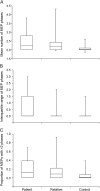Motor evoked potential polyphasia: a novel endophenotype of idiopathic generalized epilepsy
- PMID: 25740859
- PMCID: PMC4388750
- DOI: 10.1212/WNL.0000000000001413
Motor evoked potential polyphasia: a novel endophenotype of idiopathic generalized epilepsy
Abstract
Objective: We compared the motor evoked potential (MEP) phases using transcranial magnetic stimulation in patients with idiopathic generalized epilepsy (IGE), their relatives, and healthy controls, hypothesizing that patients and their unaffected relatives may share a subtle pathophysiologic abnormality.
Methods: In a cross-sectional study, we investigated 23 patients with IGE, 34 first-degree relatives, and 30 matched healthy controls. Transcranial magnetic stimulation was performed to produce a series of suprathreshold single-pulse MEPs. A semiautomated method was used to count phases. We compared between groups the mean number of MEP phases, the stimulus-to-stimulus variability in MEP phases, and the proportion of polyphasic MEPs within subjects.
Results: Patients with IGE and their relatives had a significantly increased number of MEP phases (median for patients 2.24, relatives 2.17, controls 2.01) and a significantly higher proportion of MEPs with more than 2 phases than controls (median for patients 0.118, relatives 0.088, controls 0.013). Patients had a greater stimulus-to-stimulus variability in number of MEP phases than controls. There were no differences between patients and relatives.
Conclusion: Increased MEP polyphasia in patients with IGE and their first-degree relatives may reflect transient abnormal evoked oscillations. The presence of polyphasic MEPs in relatives as well as patients suggests that MEP polyphasia is not related to treatment, and is in isolation insufficient to predispose to epilepsy. Polyphasic MEP may be a novel endophenotype in IGE.
© 2015 American Academy of Neurology.
Figures



Comment in
- Neurology. 2015 Oct 6;85(14):1262
-
Motor evoked potential polyphasia: A novel endophenotype of idiopathic generalized epilepsy.Neurology. 2015 Oct 6;85(14):1262. doi: 10.1212/WNL.0000000000002012. Neurology. 2015. PMID: 26438619 No abstract available.
-
Author Response:Neurology. 2015 Oct 6;85(14):1262. Neurology. 2015. PMID: 26716144 No abstract available.
References
-
- Badawy RA, Freestone DR, Lai A, Cook MJ. Epilepsy: ever-changing states of cortical excitability. Neuroscience 2012;222:89–99. - PubMed
-
- Gardiner M. Genetics of idiopathic generalized epilepsies. Epilepsia 2005;46(suppl 9):15–20. - PubMed
-
- Badawy RAB, Curatolo JM, Newton M, Berkovic SF, Macdonell RAL. Changes in cortical excitability differentiate generalized and focal epilepsy. Ann Neurol 2007;61:324–331. - PubMed
-
- Manganotti P, Tamburin S, Bongiovanni LG, Zanette G, Fiaschi A. Motor responses to afferent stimulation in juvenile myoclonic epilepsy. Epilepsia 2004;45:77–80. - PubMed
-
- Kohara N, Kaji R, Kojima Y, Kimura J. An electrophysiological study of the corticospinal projections in amyotrophic lateral sclerosis. Clin Neurophysiol 1999;110:1123–1132. - PubMed
Publication types
MeSH terms
Supplementary concepts
Grants and funding
LinkOut - more resources
Full Text Sources
